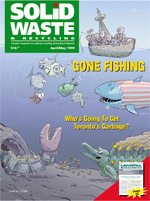Toronto’s Solid Waste Management Marketplace Engagement Program

Like other Canadian cities that are exhausting their local capacity disposal, the City of Toronto (population 2.4 million) will soon close its largest landfill. When the Keele Valley landfill shuts down in 2002, about 30 million tonnes of municipal and commercial wastes and recyclables will be left without a home for the next twenty years.
Enter the Solid Waste Management Marketplace Engagement Program or SWM-MEP (pronounced swim-mep), Toronto’s new process to identify long term disposal and diversion options. The city has looked at options since the failed Solid Waste Environmental Assessment Plan (SWEAP) in 1986. Thirteen years and five attempts later (see side bar, page 11), time is running out and SWM-MEP is under pressure to produce results.
Though critics fear it may have become another failed exercise, this process is designed to unleash competitive market forces. The newly amalgamated Toronto City Council chose this as the preferred strategy and it may result in interesting partnerships.
Toronto is collaborating with the adjacent regions of York, Durham and Peel, which have joined the process as “members.” These regions have supplied Toronto with their waste projections. They will also provide input at the different stages, but are free to opt out of partnerships at the RFP or contract signing stage.
SWM-MEP will solicit proposals for diversion and disposal options as well as new and emerging technologies. However, long term disposal capacity must not compete with (or be a disincentive to) Toronto’s aggressive waste diversion program. (City council is committed to divert 50 per cent of waste from disposal by 2006).

